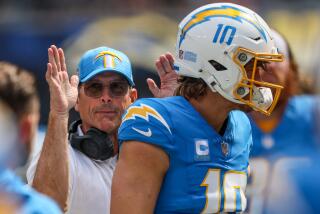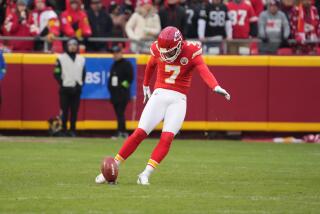Arena Football’s Growing Pains : Rash of Injuries Prompts Fledgling League to Study Safety
- Share via
WASHINGTON — Through three exhibitions and the first two games of its season, Arena Football teams had only one major injury. But after four players were knocked out for the season last weekend, league officials say they are concerned about safety and expect to have some modifications in place for this weekend’s two games.
During the Washington Commandos’ 36-20 victory over the Denver Dynamite at Capital Centre last Saturday, three players were knocked out for the season: Washington wide receiver Richard DuPree (knee), Denver quarterback Marty Mornhinweg (knee) and Denver defensive back Larry Friday (thumb). In Chicago, Pittsburgh quarterback Mike Hohensee suffered a knee injury that probably will end his season.
As the Commandos prepare to play in Denver Friday night, league officials say they are focusing on several concerns. Is the field, covered by thin artificial grass, too hard? Are there too many players on too small a playing surface? Are blitzing defensive backs too close to quarterbacks? Are there too many people converging to grab kicks that bounce off the goalside nets? And, is single platoon football tiring players and making them prone to injury?
“I’m very concerned,” said Mouse Davis, the league’s executive director of football operations. “There’s no question about it.”
Although Davis says his biggest worries are fatigue, blitzing and overcrowding under the nets, Mark Murphy of the National Football League Players Assn. says there is more to worry about.
“There seems to be very little padding under the turf, and the small size of the field could be a problem,” he said. “The other thing is, there is a very wide-open style of play and most of our studies have shown there are more injuries on passing plays than on running plays.”
Murphy said the Arena players have yet to form a union or association, but might want to because of the injury risk. Currently, players are covered by a standard workman’s compensation contract, which Foster says will cover medical expenses for injured players and pay them a salary roughly equivalent to this year’s standard of $500 a game.
Fatigue is mentioned by most people around the league as a possible cause for the injuries. But eliminating single platoon football is not being considered, according to Davis. “We would like to keep the excitement of the game,” he said, “but we want to make it as safe as possible.”
Many players arrived at the league’s two-week training camp in Wheaton, Ill., on May 29 with little chance to prepare beforehand. Several players had attended open tryout camps only weeks before, and since many of them have been out of football for a year or two, some were not in top shape.
“They’re just not conditioned enough to make it,” said Joe Haering, who coaches Pittsburgh’s Arena Football team. “To go into a season of this, you need about three or four months of high-intensity conditioning.”
Coach Ray Jauch, whose Chicago team has lost four players to injuries this season, said he would like to see a “liberalization” of the substitution rules, which currently force all players except the kicker and two others to play both offense and defense. The league’s medical director, Dr. Chadwick Prodromos of Chicago, said he is studying the effects of the single platoon, but added that most of the significant injuries so far have come early in the game.
The knee injuries to Hohensee and Mornhinweg both came in the second quarter. They also came when both quarterbacks were sacked. The injuries have prompted Davis to look closer at blitzing rules. Because of the small field and eight-man teams, a blitzing defensive back is only one man away from the quarterback, as opposed to two in 11-man football.
As a partial remedy, Davis has convinced coaches to stop fake blitzing. He thinks this might help linemen protect their quarterback better.
Denver Coach Tim Marcum said Mornhinweg’s injury could have been avoided on grass, because his quarterback’s foot caught in the artificial turf as he rolled over on his knee. But Hohensee, a former USFL Washington Federals quarterback, said his injury “didn’t have to do with the carpet, the walls or anything.”
Davis’ other modification plan involves avoiding what he described as “a melee” underneath goal-side nets on short kickoffs. After Chicago’s Troy Hill reinjured a knee on such a play, Davis decided to prohibit the kicking team from going past the 10-yard line on kickoffs from midfield or closer.
League president and founder Jim Foster said players haven’t complained about the surface’s hardness, although Denver trainer Larry Franca said Friday’s injury would not have been as bad if it had occurred on grass or on a better padded surface. Friday suffered a compound dislocation of his thumb when he jammed it into the surface during a tackle.
The thick, high-density foam padding surrounding the field has been adequate, said Prodromos, who added that, because of the narrow field, players haven’t hit the sidelines barriers with the lateral momentum an outdoor player might. Still, Washington quarterback Rich Ingold said some players would prefer a little more room between the sideline and the barriers in front of the stands.
More to Read
Go beyond the scoreboard
Get the latest on L.A.'s teams in the daily Sports Report newsletter.
You may occasionally receive promotional content from the Los Angeles Times.










